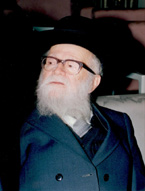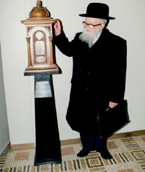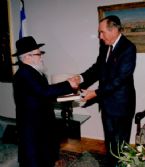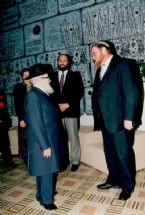HIS LIFE STORY - CONTINUED
In 5698 (1938), he was appointed as Kfar HaRoeh’s first rabbi (the first moshav to appoint a rabbi). The conditions at the pioneering moshav were difficult. It was there that questions of the utmost severity and relevance were raised regarding the agriculturally-bound halachot, such as the laws of Shmitta, kelayim and even milking on Shabbat. Here he authored his first book, Eretz Hemdah, “to clarify the halacha and its application to agricultural life.” [The book was completed on the date of the establishment of the State of Israel, and was first published in 5617 (1957).] Afterwards, he greatly strove to promote these halachot in the entire religious settlement. Rav Yisraeli arrived at Kfar HaRoeh at the age of 28. For twenty-eight years he served as rav until 5728 (1968). According to members of Kfar HaRoeh, “he transformed them to ‘almost’ rabbis, and they almost turned him into a farmer.”
While at Kfar HaRoeh, he also taught the youth, at first in the yeshiva high school, which was founded by Rav Moshe Tzvi Neriah, zt”l (according to his testimony, Rav Niriah chose Kfar HaRoeh due to Rav Yisraeli’s presence there). Afterwards, he taught at Midrashiyat Noam in Pardes Chana, where he wrote the book Perakim beMachshevet Yisrael, “an anthology of sources to clarify the main ideas of Jewish philosophy (first edition 5712/1952).” He made the subject officially recognized in learning programs and transformed it into a tested subject in the Israeli matriculation exams.
In 5909 (1949), he founded “the rabbinical membership of HaPoel Mizrachi” on the porch of his home. Rav Yisraeli was one of its leaders for many years. He founded and edited for thirteen years the greatly influential journal, HaTorah ve’HaMedinah, which greatly influenced HaPoel Mizrachi’s rabbinical membership. His in-depth analysis was collected in his book, Amud HaYemini, “halachic clarification regarding the State, responsa, and clarification of issues in several areas of the Torah (first edition 5726/1966),” which constitutes, until today, an indiepensable book on the subjects of Torah and the State of Israel. He also initiated a nusach, wording for prayers for Israel Independence Day, which was presented in preparation for the first [celebration of] Yom HaAtzma’ut to the chief rabbis of Israel and was subsequently approved by them.
In 5713 (1953), he was appointed to the Chief Rabbinate’s extended council. For many years, he was an active member of the council and even held several senior positions on their behalf. In particular, he held responsibilities in the department of agriculturally-bound mitzvot. In this framework, he propagated the fulfillment of Shmitta observance in all of Israel and transformed Shmitta observance on the official level (cf. BeTzeit HaShana, published by Heichal Shlomo, 5720/1960). He edited the journal Shana be’Shana for several years.
In 5725 (1965), he was appointed to the rabbinical high court (for appeals). As a result, he left Kfar HaRoeh. He sat on the beit din for fifteen years until his retirement. Under his tenure, he ruled on hundreds of cases, many of which were fundamental to religious law in Israel. His rulings were subsequently published in his books, Havat Binyamin (5752/1992) and Mishpatei Shaul (5757/1997).
In 5719 (1959), he was asked by Rav Tzvi Yehuda HaKohen Kook, zt”l, the rosh yeshiva of Merkaz HaRav, to deliver a shiur klali there. Afterwards, for a period of thirty-six years, until two months before his passing, he diligently gave a weekly discourse. Thousands of talmidim, some of whom became future teachers and roshei yeshiva, basked in his words of Torah. From 5742 (1982) he served as rosh yeshiva, together with Rav Avraham Shapira, zt”l. During this time, Rav Yisraeli’s discourses and sermons became very popular, especially at Yom Yerushalayim assemblies (these sermons are included in the book Zeh HaYom Asah Hashem, “sermons and essays for Yom HaAtzmaut and Yom Yerushalayim”, which include a CD recording of three of his discourses, 5763/2003).
In 5747 (1987), he founded the Eretz Hemdah Institute for Advanced Jewish Studies and served as its president. He edited the journal Barkai and was a member of Da’at Mikra’s editorial board.
He paved the way and was one of the spiritual leaders of religious Zionism for close to sixty years. For his contributions, he was granted: the Rav Kook Prize in Torah Literature (5719/1959), the Rav Maimon Prize (5732/1972), the Haim-Moshe Shapira Prize (5750/1990), and the Israel Prize in Torah Literature (5752/1992).
He returned his soul to his Maker on the 19th of Sivan, 5755 (June 17, 1995).
Additional biographical sources portraying his great deeds and personality can be found in: Gaon baTorah Ubamidot, “chapters in the way and image of the Gaon Rav Shaul Yisraeli, zt”l”, Erez Press, 5759 (1999); and the Encyclopedia to Religious Zionism, Mosad HaRav Kook.

Top of page

Print this page

Send to friend









